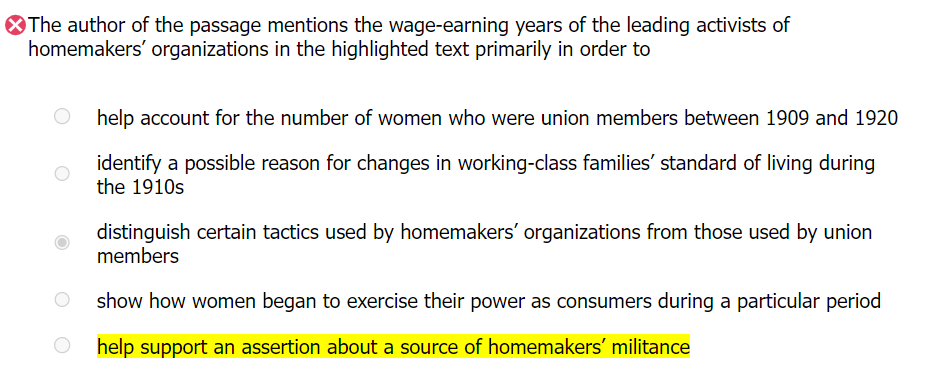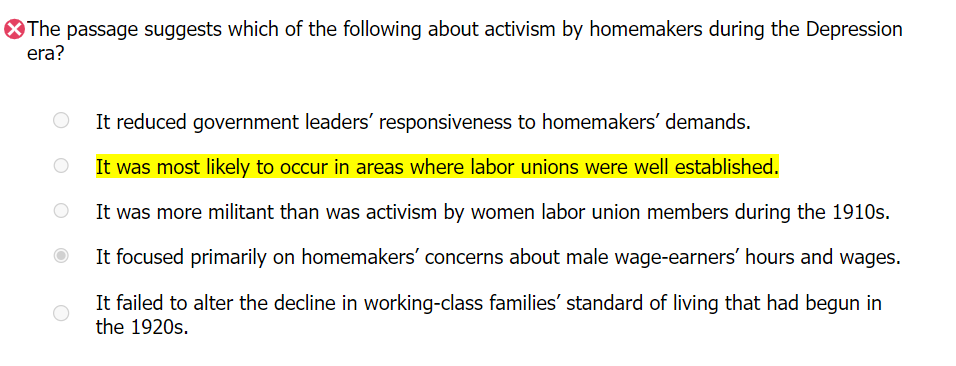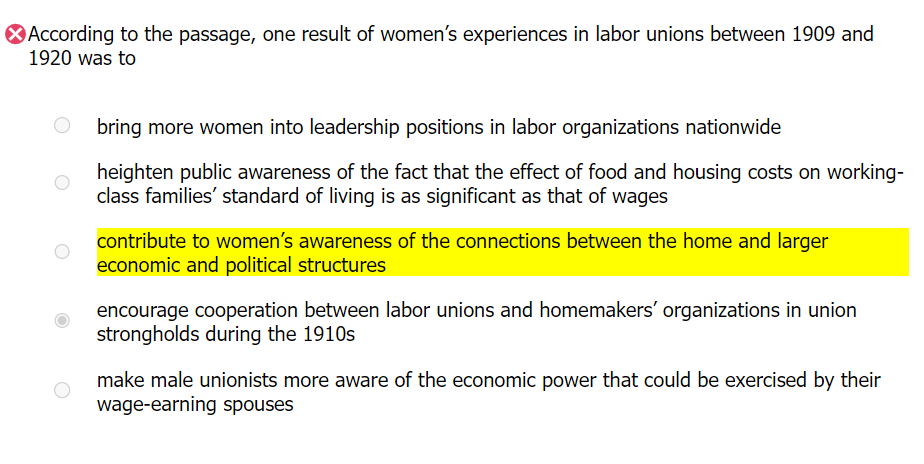Events & Promotions
|
|

GMAT Club Daily Prep
Thank you for using the timer - this advanced tool can estimate your performance and suggest more practice questions. We have subscribed you to Daily Prep Questions via email.
Customized
for You
Track
Your Progress
Practice
Pays
Not interested in getting valuable practice questions and articles delivered to your email? No problem, unsubscribe here.
- Nov 20
07:30 AM PST
-08:30 AM PST
Learn what truly sets the UC Riverside MBA apart and how it helps in your professional growth - Nov 19
12:30 PM EST
-01:30 PM EST
Learn how Keshav, a Chartered Accountant, scored an impressive 705 on GMAT in just 30 days with GMATWhiz's expert guidance. In this video, he shares preparation tips and strategies that worked for him, including the mock, time management, and more - Nov 20
01:30 PM EST
-02:30 PM IST
Learn how Kamakshi achieved a GMAT 675 with an impressive 96th %ile in Data Insights. Discover the unique methods and exam strategies that helped her excel in DI along with other sections for a balanced and high score. - Nov 22
11:00 AM IST
-01:00 PM IST
Do RC/MSR passages scare you? e-GMAT is conducting a masterclass to help you learn – Learn effective reading strategies Tackle difficult RC & MSR with confidence Excel in timed test environment - Nov 23
11:00 AM IST
-01:00 PM IST
Attend this free GMAT Algebra Webinar and learn how to master the most challenging Inequalities and Absolute Value problems with ease. - Nov 24
07:00 PM PST
-08:00 PM PST
Full-length FE mock with insightful analytics, weakness diagnosis, and video explanations! - Nov 25
10:00 AM EST
-11:00 AM EST
Prefer video-based learning? The Target Test Prep OnDemand course is a one-of-a-kind video masterclass featuring 400 hours of lecture-style teaching by Scott Woodbury-Stewart, founder of Target Test Prep and one of the most accomplished GMAT instructors.
Kudos
Bookmarks
Question 1
E
Be sure to select an answer first to save it in the Error Log before revealing the correct answer (OA)!
Difficulty:
 55%
(hard)
55%
(hard)
Question Stats:
58% (02:56) correct 42%
(02:48) wrong
42%
(02:48) wrong  based on 825
sessions
based on 825
sessions
History
Date
Time
Result
Not Attempted Yet
Question 2
B
Be sure to select an answer first to save it in the Error Log before revealing the correct answer (OA)!
Difficulty:
 45%
(medium)
45%
(medium)
Question Stats:
64% (01:21) correct 36%
(01:30) wrong
36%
(01:30) wrong  based on 863
sessions
based on 863
sessions
History
Date
Time
Result
Not Attempted Yet
Question 3
C
Be sure to select an answer first to save it in the Error Log before revealing the correct answer (OA)!
Difficulty:
 15%
(low)
15%
(low)
Question Stats:
76% (01:07) correct 24%
(01:15) wrong
24%
(01:15) wrong  based on 826
sessions
based on 826
sessions
History
Date
Time
Result
Not Attempted Yet
Historian Annelise Orleck points out most scholars’ neglect of an important Depression-era (1929-1939) phenomenon in the United States: activism by working-class homemakers who lobbied for food and rent price controls, staged anti-eviction demonstrations and food boycotts, and created large-scale barter networks. Orleck’s research on homemakers' groups acknowledges regional differences in their political styles, but emphasizes a significant commonality: a strong labor- movement affiliation. Male unionists’ wage victories during the 1910s had improved working-class families’ standard of living, but spiraling inflation and the near-destruction of many unions during the 1920s sharply eroded these gains. Depression-era homemakers' militance was sparked by this steep decline in working-class families’ standard of living. It was also rooted in female organizers’ own union experiences. In areas where homemakers' organizations flourished, usually union strongholds, women commonly worked for wages before marriage. The wage-earning years of most leading activists in these organizations coincided with a period marked by women’s labor militance: 1909 to 1920. Women’s union experiences shaped their understanding of the home as enmeshed in a web of social and economic relationships that included unions, the marketplace, and the government. By organizing as consumers. Depression-era women shattered stereotypes of the passive homemaker, showed a keen understanding of their place in larger economic structures, and demonstrated that food and housing, like wages and hours, could be regulated by applying economic pressure.
1. The author of the passage mentions the wage-earning years of the leading activists of homemakers' organizations in the highlighted text primarily in order to
A. help account for the number of women who were union members between 1909 and 1920
B. identify a possible reason for changes in working-class families’ standard of living during the 1910s
C. distinguish certain tactics used by homemakers' organizations from those used by union members
D. show how women began to exercise their power as consumers during a particular period
E. help support an assertion about a source of homemakers' militance
A. help account for the number of women who were union members between 1909 and 1920
B. identify a possible reason for changes in working-class families’ standard of living during the 1910s
C. distinguish certain tactics used by homemakers' organizations from those used by union members
D. show how women began to exercise their power as consumers during a particular period
E. help support an assertion about a source of homemakers' militance
2. The passage suggests which of the following about activism by homemakers during the Depression era?
A. It reduced government leaders’ responsiveness to homemakers' demands.
B. It was most likely to occur in areas where labor unions were well established.
C. It was more militant than was activism by women labor union members during the 1910s.
D. It focused primarily on homemakers' concerns about male wage-earners' hours and wages.
E. It failed to alter the decline in working-class families’ standard of living that had begun in the 1920s.
A. It reduced government leaders’ responsiveness to homemakers' demands.
B. It was most likely to occur in areas where labor unions were well established.
C. It was more militant than was activism by women labor union members during the 1910s.
D. It focused primarily on homemakers' concerns about male wage-earners' hours and wages.
E. It failed to alter the decline in working-class families’ standard of living that had begun in the 1920s.
3. According to the passage, one result of women’s experiences in labor unions between 1909 and 1920 was to
A. bring more women into leadership positions in labor organizations nationwide
B. heighten public awareness of the fact that the effect of food and housing costs on working- class families’ standard of living is as significant as that of wages
C. contribute to women’s awareness of the connections between the home and larger economic and political structures
D. encourage cooperation between labor unions and homemakers' organizations in union strongholds during the 1910s
E. make male unionists more aware of the economic power that could be exercised by their wage-earning spouses
A. bring more women into leadership positions in labor organizations nationwide
B. heighten public awareness of the fact that the effect of food and housing costs on working- class families’ standard of living is as significant as that of wages
C. contribute to women’s awareness of the connections between the home and larger economic and political structures
D. encourage cooperation between labor unions and homemakers' organizations in union strongholds during the 1910s
E. make male unionists more aware of the economic power that could be exercised by their wage-earning spouses

4.png [ 138.23 KiB | Viewed 10339 times ]

5.png [ 58.07 KiB | Viewed 10333 times ]

6.png [ 52.93 KiB | Viewed 10334 times ]

7.png [ 68.79 KiB | Viewed 10341 times ]
Attachment:
4.png [ 138.23 KiB | Viewed 10339 times ]
Attachment:
5.png [ 58.07 KiB | Viewed 10333 times ]
Attachment:
6.png [ 52.93 KiB | Viewed 10334 times ]
Attachment:
7.png [ 68.79 KiB | Viewed 10341 times ]
1. The author of the passage mentions the wage-earning years of the leading activists of homemakers' organizations in the highlighted text primarily in order to
The wage-earning years of most leading activists in these organizations coincided with a period marked by women’s labor militance: 1909 to 1920. Women’s union experiences shaped their understanding of the home as enmeshed in a web of social and economic relationships that included unions, the marketplace, and the government.
A. help account for the number of women who were union members between 1909 and 1920 - irrelevant , focus of passage is related to involvement of women relative to men, focus is not on wheather women involvement increased decreased etc.
B. identify a possible reason for changes in working-class families’ standard of living during the 1910s - irrelevant
C. distinguish certain tactics used by homemakers' organizations from those used by union members - irrelevant
D. show how women began to exercise their power as consumers during a particular period - This does not answer how women began to exercise their power but rather what led them to participate in the activism
E. help support an assertion about a source of homemakers' militance - Correct since this statement explains what was the source or rather how women's role in these activism started what shaped their understanding
2. The passage suggests which of the following about activism by homemakers during the Depression era?
In areas where homemakers' organizations flourished, usually union strongholds, women commonly worked for wages before marriage.
A. It reduced government leaders’ responsiveness to homemakers' demands. - no mention of govt's change of attitude
B. It was most likely to occur in areas where labor unions were well established. - Correct, Clearly suggested in passage
C. It was more militant than was activism by women labor union members during the 1910s. - more militant or less is not mentioned in passage
D. It focused primarily on homemakers' concerns about male wage-earners' hours and wages. - not mentioned in passage
E. It failed to alter the decline in working-class families’ standard of living that had begun in the 1920s. - We don't know if living standards improvement failed, but we atleast know they managed to demostrate that regulating the food and housing prices was possible!
Out of all the options only B is suggested in the passage ( not directly mentioned but suggested , we can make an inference )
3. According to the passage, one result of women’s experiences in labor unions between 1909 and 1920 was to
The wage-earning years of most leading activists in these organizations coincided with a period marked by women’s labor militance: 1909 to 1920. Women’s union experiences shaped their understanding of the home as enmeshed in a web of social and economic relationships that included unions, the marketplace, and the government.
A. bring more women into leadership positions in labor organizations nationwide
B. heighten public awareness of the fact that the effect of food and housing costs on working- class families’ standard of living is as significant as that of wages - No, no mention of motive being heightening public awareness. Though they demonstrated that economic pressure could be leveraged to achieve regulations in living and food housing.
C. contribute to women’s awareness of the connections between the home and larger economic and political structures - Correct, Passage clearly mentions the result of women's militance helped them understand home as enmeshed in a web of social and economic relationships that included unions, the marketplace, and the government.
D. encourage cooperation between labor unions and homemakers' organizations in union strongholds during the 1910s
E. make male unionists more aware of the economic power that could be exercised by their wage-earning spouses
The wage-earning years of most leading activists in these organizations coincided with a period marked by women’s labor militance: 1909 to 1920. Women’s union experiences shaped their understanding of the home as enmeshed in a web of social and economic relationships that included unions, the marketplace, and the government.
A. help account for the number of women who were union members between 1909 and 1920 - irrelevant , focus of passage is related to involvement of women relative to men, focus is not on wheather women involvement increased decreased etc.
B. identify a possible reason for changes in working-class families’ standard of living during the 1910s - irrelevant
C. distinguish certain tactics used by homemakers' organizations from those used by union members - irrelevant
D. show how women began to exercise their power as consumers during a particular period - This does not answer how women began to exercise their power but rather what led them to participate in the activism
E. help support an assertion about a source of homemakers' militance - Correct since this statement explains what was the source or rather how women's role in these activism started what shaped their understanding
2. The passage suggests which of the following about activism by homemakers during the Depression era?
In areas where homemakers' organizations flourished, usually union strongholds, women commonly worked for wages before marriage.
A. It reduced government leaders’ responsiveness to homemakers' demands. - no mention of govt's change of attitude
B. It was most likely to occur in areas where labor unions were well established. - Correct, Clearly suggested in passage
C. It was more militant than was activism by women labor union members during the 1910s. - more militant or less is not mentioned in passage
D. It focused primarily on homemakers' concerns about male wage-earners' hours and wages. - not mentioned in passage
E. It failed to alter the decline in working-class families’ standard of living that had begun in the 1920s. - We don't know if living standards improvement failed, but we atleast know they managed to demostrate that regulating the food and housing prices was possible!
Out of all the options only B is suggested in the passage ( not directly mentioned but suggested , we can make an inference )
3. According to the passage, one result of women’s experiences in labor unions between 1909 and 1920 was to
The wage-earning years of most leading activists in these organizations coincided with a period marked by women’s labor militance: 1909 to 1920. Women’s union experiences shaped their understanding of the home as enmeshed in a web of social and economic relationships that included unions, the marketplace, and the government.
A. bring more women into leadership positions in labor organizations nationwide
B. heighten public awareness of the fact that the effect of food and housing costs on working- class families’ standard of living is as significant as that of wages - No, no mention of motive being heightening public awareness. Though they demonstrated that economic pressure could be leveraged to achieve regulations in living and food housing.
C. contribute to women’s awareness of the connections between the home and larger economic and political structures - Correct, Passage clearly mentions the result of women's militance helped them understand home as enmeshed in a web of social and economic relationships that included unions, the marketplace, and the government.
D. encourage cooperation between labor unions and homemakers' organizations in union strongholds during the 1910s
E. make male unionists more aware of the economic power that could be exercised by their wage-earning spouses
Kudos
Bookmarks
















